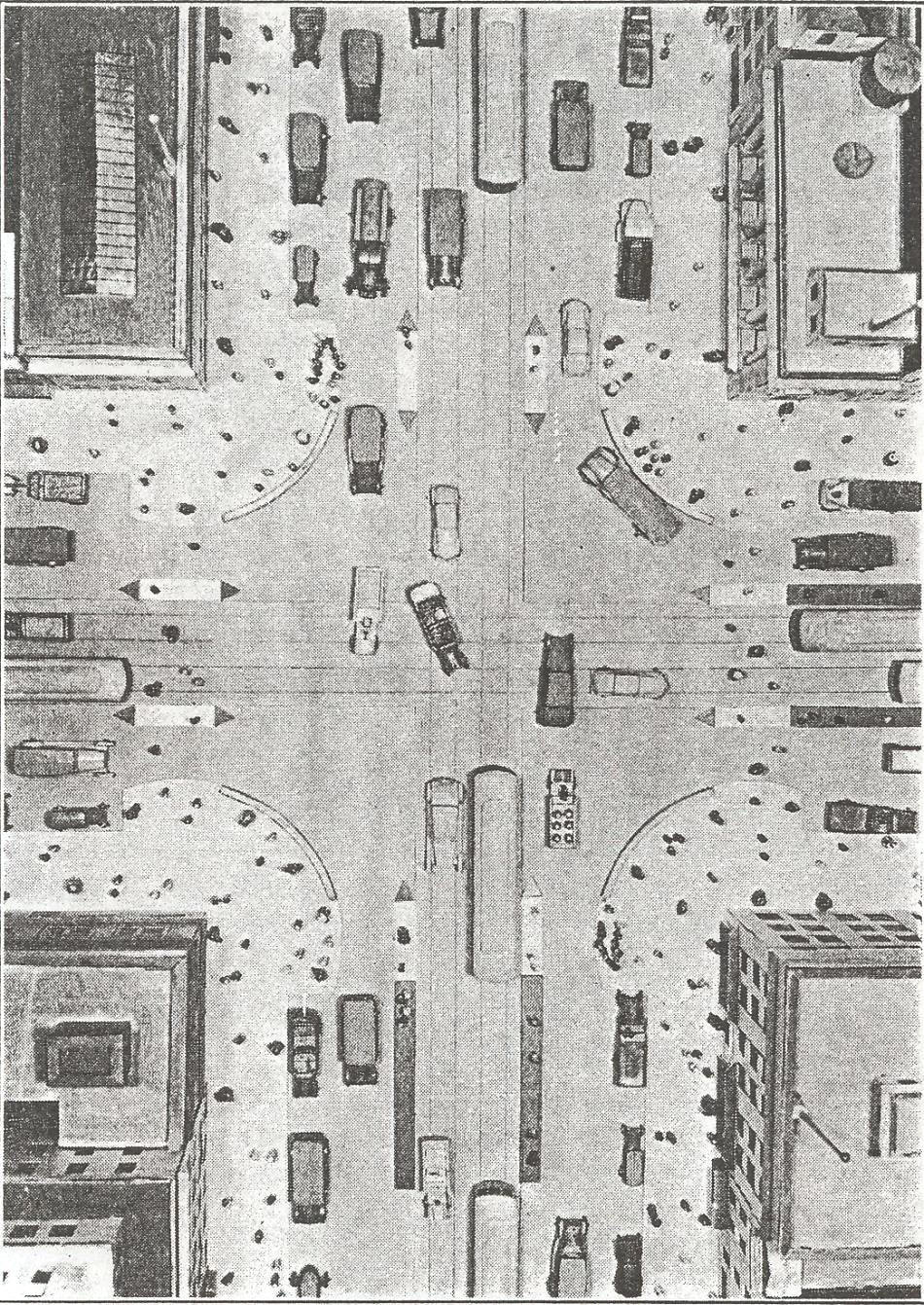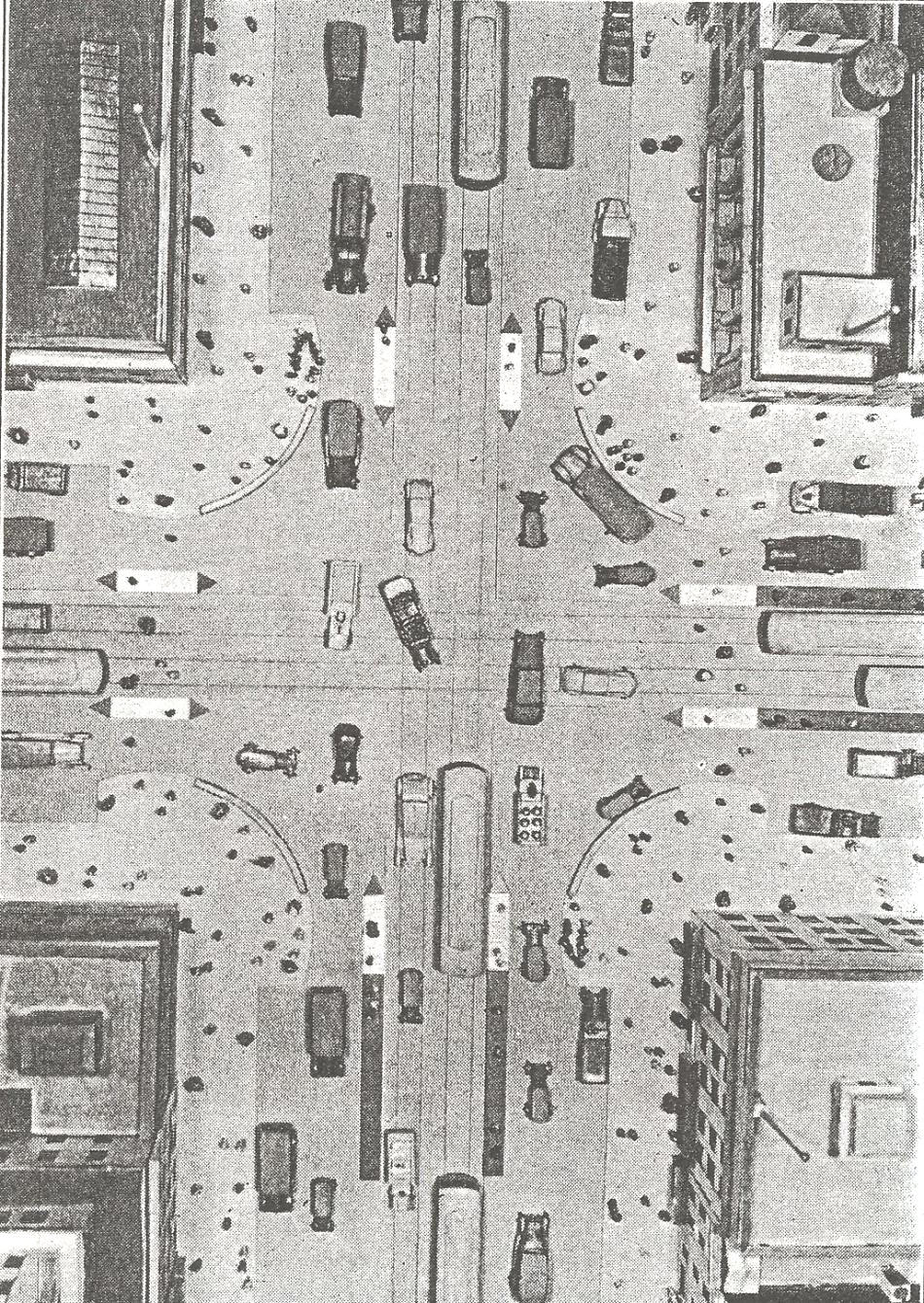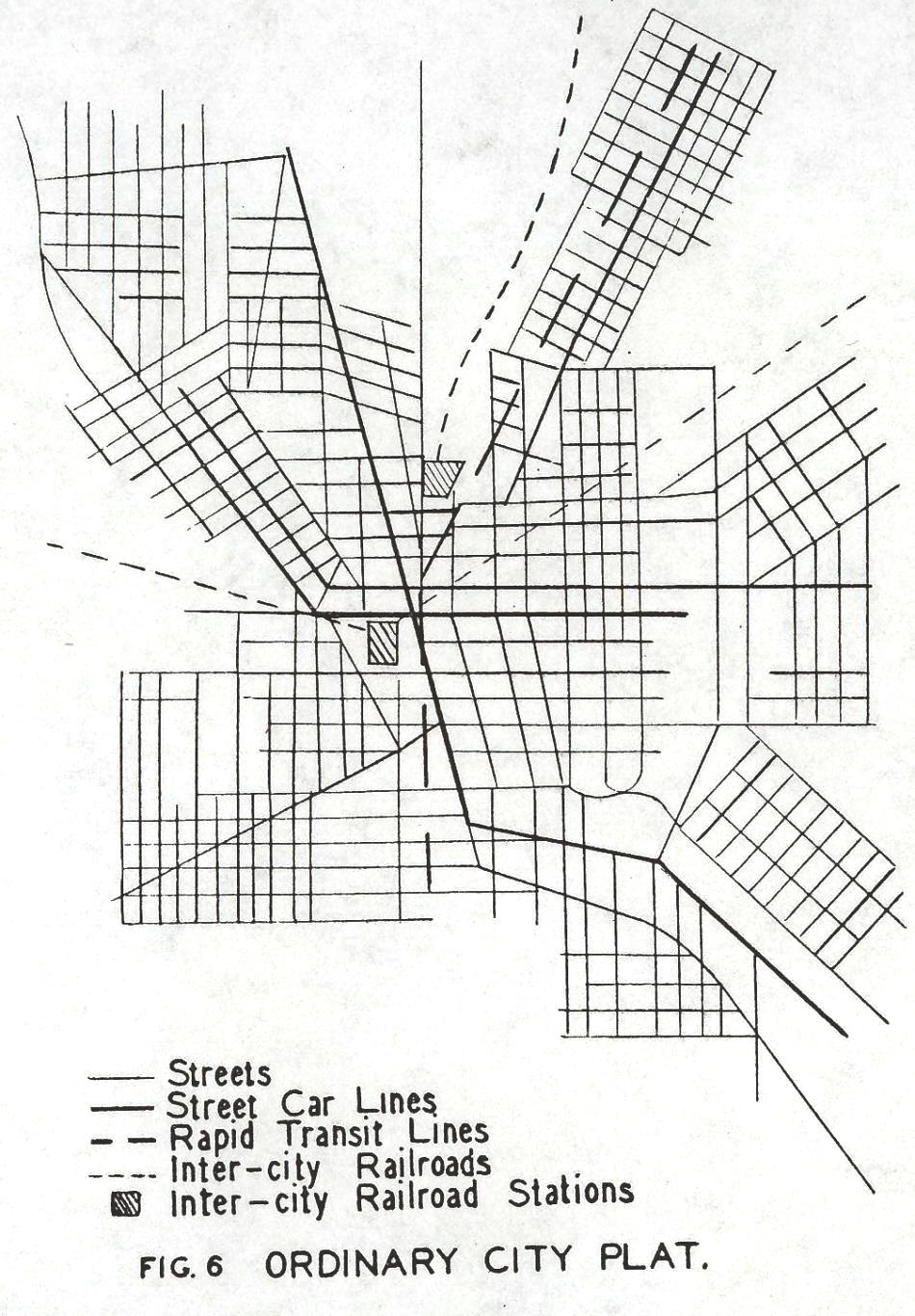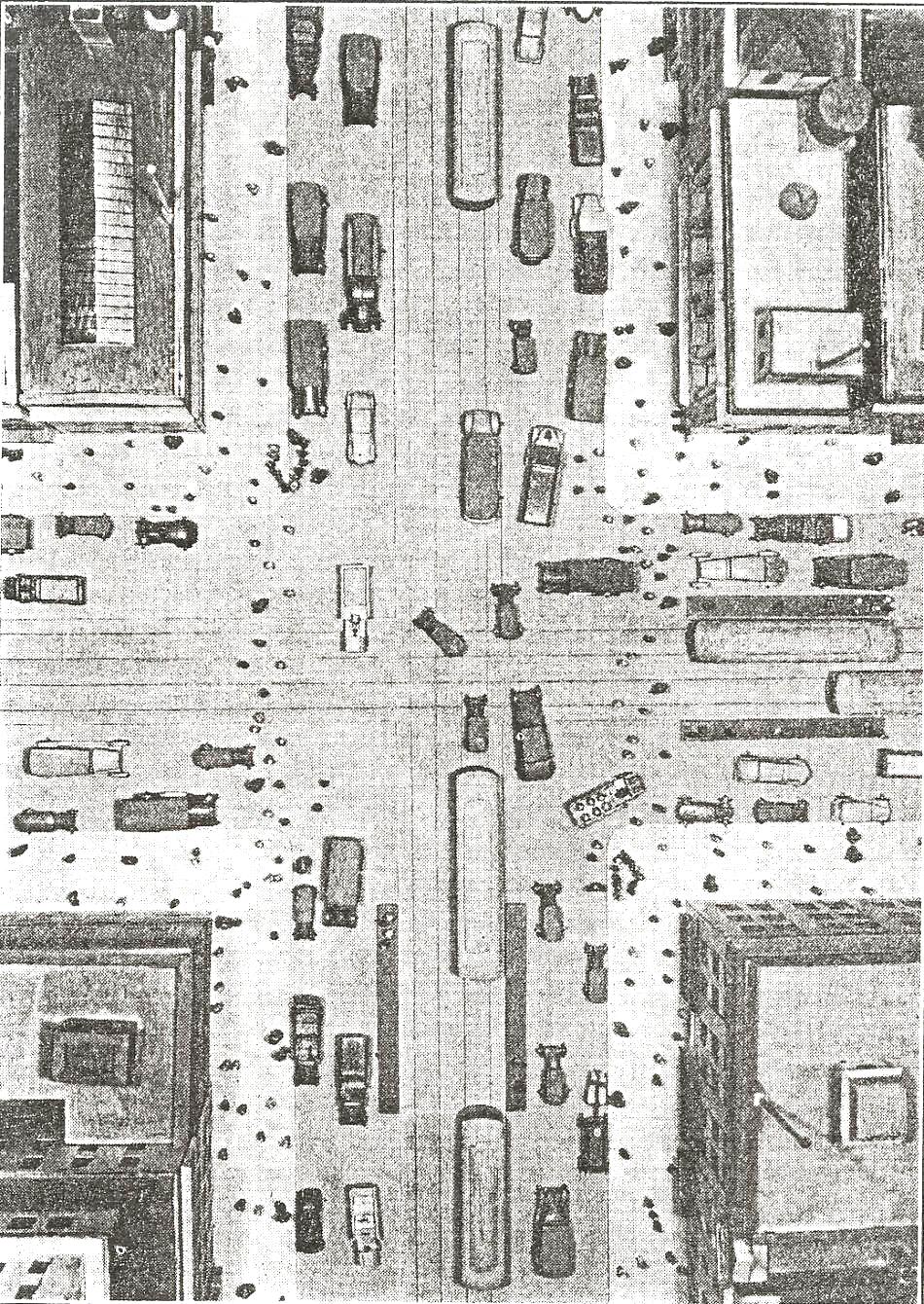
Fig. 4
Home Page Table of Contents Next Section
|
COLLISIONS IN STREET AND HIGHWAY TRANSPORTATION W. J. Sidis |
100. Methods of Supervising Taxicabs. 101. The Headquarters System. The methods of supervising taxicabs in use a few years ago, required a cab to start from headquarters in response to a call from the prospective patron. A dead mileage trip was made to the origin of the passenger’s ride. The paying trip from origin to destination followed. The fare was usually based upon the reading of a taximeter and included charges for waiting time. The final leg of the triangular journey was a dead mileage return trip to headquarters. The lack of economy in dead mileage, the loss of time for the passenger waiting for the cab making its first dead mileage trip, and sometimes a further loss of time in waiting for a cab still engaged in making the last dead mileage trip of the preceding call, and finally the obvious efficiency and economy resulting when cabs made pickups on the street, lead to the introduction of cruising.
102. Cruising. Cruising refers to the practice of continuously driving the taxicab through the streets in search of a pickup; and far from solving the difficulties of the cab system operated from headquarters, merely substituted a new set of problems. The loss due to dead mileage still remains; and the uncertainties and waiting required of the passenger for a cab called from the taxicab office, are replaced by the waiting upon the street corner, with its attendant uncertainties. The last difficulty is met fairly well when cabs become very numerous; but a still newer difficulty is experienced in the losses and congestion due to having perhaps ten cabs passing an important corner, for every one hired by a patron.
Some students of transportation make much of the fact that a street car occupies less street space per passenger than a private motor car with its average load of one or two passengers; the discrepancy created by ten taxicabs per passenger is, obviously, far worse. Other factors enter into the problem, but the question of wear upon the street surface must be considered in attempting to evaluate this increasingly important phase of the mass transportation problem. The change from the headquarters system to cruising resulted, largely, in the abandonment of company management over operators, at least in so far as dealings with patrons were concerned. Most operators are, in effect, independently in the taxicab business, and are ostensibly buying their cars on the daily installment plan.
103. Cab Stands. (1) The use of cab stands scattered around the city, is a modification of the original headquarters system, and is a compromise in regard to costs, passenger’s time and convenience, and various other factors. (2) It would appear that cab stands located upon private property, and having at least some of the conveniences for passengers and operators that are commonly found in stations, would be the ideal solution of this problem, but unfortunately many cab drivers find cruising brings better financial returns than waiting at a cab stand. It would also greatly increase cab fares if station costs were added. Cabs proceeding from the central business district to suburban points with patrons, are frequently obliged to return most of the distance on dead mileage, and thereby involuntarily become cruisers.
104. Proposals for Solution. In view of the economic waste and obstruction resulting from the cruising practice, police officials frequently endeavor to solve the difficulty by establishing a considerable number of cab stands throughout the city. Cabs are required to proceed to the nearest stand after being dismissed by a patron. With certain modifications this plan is recommended by the author. As usually carried out, the large number and wide distribution of the stands is expected to off-set any inconvenience to the public in the matter of walking to a stand rather than waiting for a cab. In addition, a plan is required for permitting cabs to cruise when a driver is unable to find a vacant place at a regular stand, or when transportation demands indicate that the public will be better served by allowing a certain amount of controlled cruising. The police department probably lacks the essential statistical information which would enable it to specify how much cruising might be permitted at any point at any particular time of the day. It also lacks methods of supervising the cabs which are cruising in the central business district, unless it wishes to establish hard and fast prohibitory rules.
105. The Inner Taxicab Zone. In offering a plan for solution, the first consideration is to note that a taxicab should be permitted to return from an outlying point in or near the city, to a point, let us say, at the edge of the central business district if the driver so desires. He may use his own preference as to stopping at any point outside of this district. Cruising within the central business district is that which is most in need of supervision; therefore an inner taxicab zone should be established. This zone will cover the area requiring control over cruising.
106. The Taxicab Supervisor. A city official whom we may call the Taxicab Supervisor, is expected to receive a telephone report from every taxicab driver who enters the inner zone without a patron. The driver is then instructed to follow an established and numbered route until he picks up a patron or again reaches the edge of the zone, where he again reports if he wishes to re-enter the inner zone.
Taxicabs carrying patrons would not be reported when entering or leaving the inner zone. A short interval after the establishment of the office, the Taxicab Supervisor would have sufficient data to guide him in his practice. He would know, at any time of the day, which routes had a deficiency or surplus of unoccupied cabs, and base his instructions upon this information. The methods of routing should be for the greatest service to the public, with the least obstruction of the streets. He should also encourage but not compel the cab drivers to stop at cab stands. He would not be expected to send cabs to particular addresses upon requests of patrons, but in so far as the inner zone is concerned, information from citizens desiring cabs would be of value in route instructions to drivers entering the zone. He would keep detailed records of reports received and instructions given. His control would be primarily over the cruising cabs in the inner zone. Telephone stations for reporting to him would be located at points where streets cut the boundaries of the inner zone. He would be aided if there were other outlying stations where preliminary instructions might be given to drivers who were proceeding towards the inner zone: No unnecessary excess of vacant cabs would be permitted in the inner zone.
107. The Municipality’s Problem in Costs. Whatever may be the economic problems of the owners and operators of taxicabs, the economic problem of the municipality is the storing of one or more private motor cars on the streets for varying periods during the day, plus its share of the costs of operation of these cars over the streets, as compared with the municipality's share of the running and standing costs entailed by the taxicabs which would perform the service in place of the above mentioned private motor cars. By costs we mean here, all of the indirect as well as the more direct costs such as street wear and traffic direction. One taxicab will occupy far less space at the curb than the private automobiles which it replaces, particularly since the cab will be likely to stand a far less proportion of the time. On the other hand, the taxicab will probably run more miles than the sum of the mileages of the several private automobiles. The conclusions which seem to be warranted are: that taxicabs do not aggravate the parking problem but do increase the amount of moving traffic and, since they usually run at higher speed, the tendency to raise the average speed of vehicular traffic.
108. Comparison of Street Cars and Taxicabs. Figures 4, 5, and 14 represent, in a qualitative rather than in a strictly calculated quantitative way, an attempt to visualize the comparative effect upon street congestion, of street cars, taxicabs, and private motor cars. The comparison Fig. 4 with Fig. 14, relates to taxicabs and street cars. Fig. 5 and Fig. 14 show the comparison between private motor cars and street cars. Fig. 4 and Fig. 5 show the comparison between taxicabs and private motor cars. Fig. 14 shows normal traffic conditions, where there is an average assortment of private motor cars, taxicabs, street cars, and commercial vehicles. Fig. 4 was made after lifting ten taxicabs from the model. All of the ten cabs were presumed to be running, and therefore were lifted from the lanes used by moving vehicles. Streets cars were increased by one. Private motor cars (mostly parked) and commercial vehicles, running or parked, remained as before. The comparison indicated by the replacement of ten cabs by one street car, is to illustrate the relative amount of street space required by the vehicles when passengers decide to travel by street car or taxicab. The passenger enjoys certain privileges of individual control, safety in boarding and leaving his vehicle, and personal comfort and privacy when he selects a taxicab in preference to a street car. He probably increases his personal risk in so far as safety in the vehicle is concerned, in the taxicab. He helps to augment the problem in street safety and traffic congestion for the general public, by selecting the taxicab. The favorable and unfavorable factors for street car riders are discussed under “Street cars and buses” (117), and “Relation of various types of transportation vehicles to safety” (124).

Fig.
4
109. Comparison of Street Cars and Private Automobiles. Fig. 5 was made after lifting ten private automobiles (all parked) from the model. All other vehicles remained as in Fig. 14 except that one street car was added. This comparison is the well-known parking problem, created by people using private automobiles in preference to street cars or buses. It was discussed at length under “Parking” (42).
110. Comparison of Taxicabs and Private Automobiles. By comparing Fig. 4 with Fig. 5, the relation between taxicabs and private automobiles will be observed. In Fig. 4, the parking of private automobiles (along with commercial vehicles) is permitted to the extent of full occupation of the curb space. No further entrance of private automobile passengers into this district, can occur, except as space is vacated by deparking vehicles; in other words, a limiting condition has been reached. There are several alternatives, however. These are: pedestrianism, the use of street cars or buses, the use of taxicabs, and parking restrictions. Fig. 5 shows the change when a drastic no-parking order is enforced, and a marked increase in passengers using taxicabs results. As stated above, the ratios are merely illustrative, since they are difficult to calculate with accuracy. The author believes, however; that a more careful and exact analysis would not reveal any more striking comparison.
The theory of the distribution of passengers among the several classes of vehicles is more complicated than the direct comparisons indicated above, since it seems certain that if private automobiles were eliminated (by law, for instance), all riders who had been using them would not then use taxicabs; a fairly large number would use street cars.

Fig.
5
111. The Municipality’s Problem of General Passenger Transportation. Considering all of the desirable factors in housing conditions, and the transportation question including the traffic safety problem, there does not seem to be any incentive for a municipality to encourage any one type of transportation to the exclusion of any other, so long as the transportation vehicles are privately owned. It is possible, however, to envision an advanced type of rail transportation system, supplemented by free wheel vehicles as well as escalators and moving sidewalks, all under direct municipal control and, of course, thoroughly coordinated, which would be vastly superior to the hodge-podge of transportation methods usually found in 'cities and towns. A few suggestions along this line are given under “The city plan” (234), “The supercity” (253), and “The public utilities commission” (316).
112. Traffic Coordination. Traffic coordination is a division of the subject of mass transportation that is attracting considerable attention. By traffic coordination we mean, interlinking, rearranging, improving, expanding, or contracting the traffic facilities of the several interests which serve to transport freight and passengers within the city.
There are, unfortunately, reasons why we need expect no important results in this field in the near future, and we will therefore be obliged to be satisfied with a study of the subject as an academic proposition. These obstacles are: the difficulty in securing intelligent public-spirited agreement among the political leaders in a community, the citizens, and the owners of the transportation lines; the difficulty in securing agreement upon engineering features; and the large expense frequently involved in the proposed changes. Steam railroads, steamship lines, docking facilities, and even flood-control problems may be involved in the discussion.
113. Balanced Street Grid Desired. However, it does seem worth while to attempt to visualize the city with ideal traffic-facility coordination. The street plan of the ideal city would undoubtedly be a balanced grid, operated on the one-way principle. There would be street car or bus lines on as many of the streets as traffic density justified, and these would be distributed in grid form. The local buses or cars would be adequately supplemented by express buses or cars, running at considerably higher speeds than is now customary, transfer arrangements, both physical and paper, would be highly efficient. All traffic would flow freely within the city, and to and from the suburban territory, not along a few “arteries,” but along numerous streets.
114. Downtown Terminals for Intercity Lines Eliminated. All intercity transportation systems would transfer all passengers destined for that city, to the city transportation system. Downtown railroad terminals would be abolished. Freight and passenger stations would be located at the fringe of the city transit system. While it undoubtedly seems ridiculous to think of an important railroad discharging its suburban and long-distance passengers into a street car system at its outer limit, and under present conditions it would be ridiculous; yet this opinion is due, largely, to the past record of the street cars and buses for certain limitations as to speed, crowding of passengers, etc. In so far as freight terminals are concerned, the idea proposed is in a fair way of adoption; but let us consider the suburban and long-distance passengers of a steam railroad. The idea once entertained by the railroad company was that the company's facilities should take, not only its freight, but its passengers as well, to points as near as possible to their final destinations. Downtown terminals, cabs (and drays) were formerly regarded as the solution of the railroads’ distribution problem in cities. There are certain losses which make downtown railroad terminals slow and costly. They discharge practically all of their passengers into the heart of the city where they tend to produce congestion. There is a certain amount of back haul. City terminals are very expensive to construct and operate. Attempts to get into the center of the city merely cause loss of time, congestion, and needless fare charges, for they often do not save the passenger from using the local transportation system.
A schematic plat of a city having downtown terminals is shown in Fig. 6. The interference of railroad terminals with city growth is apparent. The effect of arteries and rapid transit systems leading towards a single downtown focal point and producing a centralizing tendency with resulting congestion is also apparent. The unbalanced use of streets and traffic facilities prevents this type of city from growing uniformly, and sometimes disfigures residential districts.
Fig. 49 shows the author's proposed city plat, intended to overcome the objections found in present-day plats. This figure will be described in detail under “The city plan” (234). Fig. 7 is a photograph of a model of an ordinary street intersection as found in most present-day cities. Fig. 6 and Fig. 7 may properly be studied together, since they indicate the demand for coordinated planning which is essential to the elimination of the obstruction which constitutes the transportation problem, and the destruction which constitutes the traffic problem.

Fig.
6
115. Intercity Railroads as Line Distributors. Steam railroads, as they are commonly found entering the hearts of large cities today, are not fitted for and should not form a part of a well coordinated city passenger system. They act as line or artery types of distributors and not as area distributors. However, under “A coordinated passenger terminal system” (249) the author makes a suggestion for the use of existing railroad trackage in cities, as an element in a city transportation system.
116. Subway and Elevated Railroads. Subway and elevated lines partake to a limited extent of the undesirable characteristics of the steam railroad, by being line distributors. The fact that their traffic is local in origin and that frequent stops are provided, is in their favor. Universal transfer facilities between rapid transit lines and surface lines, car or bus, are essential to satisfactory coordination of these services. Rapid transit lines upon exclusive rights-of-way have certain important advantages. They save time for the passenger, provide additional safety, and relieve crowded surface lines and sidewalks. In any city having sufficient population and business enterprises to justify the building of a supercity, and where the desires of the public lean towards the concentrated type of city plan, a grid system of rapid transit lines, adequately interlinked with the surface lines will be necessary.
Proposals are frequently made that a subway should be built in a given city to reduce or eliminate street congestion. The experience of many cities shows this philosophy to be fallacious. A slight reduction in street traffic will probably be noticed immediately after the completion of a subway in a given district; but it is to be expected that street traffic will grow rapidly, and in only a few months or years the volume will exceed that which existed before the building of the subway.

Fig.
7
117. Street Cars and Buses. In spite of a popular notion which prevails at present that street car transportation is likely to be entirely displaced by other forms of transportation, the author believes that a comfortable, roomy, rail-wheel vehicle is best adapted to the mass transportation needs of a large class of cities. The fault of “line” methods, which is to be found in intercity and suburban railroads, has also been characteristic of most street railway systems in the past; and it is this feature which places the street car in the weak position in which it finds itself when brought into competition with free-wheel vehicles.
The street car systems have attempted coordination by making bus lines adjuncts to the street cars, or in some cases the cars and tracks have been replaced by bus lines. Where the feeder buses act merely as line extensions of the tracks, then the likelihood of a rapid building up of patronage seems remote, although the convenience of these bus lines to certain individuals may be considerable. The endeavor, in coordinating street cars and buses, should aim to cover an area with suitable transportation facilities, car or bus, in a way that places but little pressure upon the residents to refrain from using the facilities. Resistance to ready inter-change of passengers at logical transfer points, walking required to reach car or bus, long waits for car or bus, crowded conveyances, and slow speed are the principal obstacles to modernization of the car and bus systems. The street car has long been regarded as a transportation agency, but present day requirements indicate that the pickup and distribution functions must be given at least as much attention as the transportation function. In the early days, street car routes often rambled in a circuitous manner in order to make the “line,” in effect, serve an area. These circuitous routes eventually became burdensome to the company and the public. Some present-day bus lines are laid out along rambling routes, although there is the saving feature that a bus route may be easily changed to suit conditions.
One feature of a bus line which appears to act as “sales resistance” is the absence of a track. The street car track had, and still has, the psychological guarantee both of service and known route. In plain words, the general public does not use buses, the auxiliary bus lines more particularly, because the people do not know that a bus can be had at a certain point; and if one happens to come along, they may not know where it will take them. Habitual riders are well served, but to the members of the general public, a bus line is often of secondary value until investigated. The pattern of the mass transportation lines should be in the mind of the general public if the lines are to be freely patronized. The pattern must necessarily have appropriate relation to the geographical features of the municipality, but systematic regularity seems paramount. Some related subjects are discussed under “Relation of various types of passenger transportation vehicles to safety” (124), “Street car transportation” (317), “Bus transportation” (325) and “Taxicab transportation” (326).
118. Private Automobiles and Taxicabs. Beyond securing equal and fair use of the streets for private motor cars and taxicabs along with the public utility vehicles there does not appear to be any need for coordination between the taxicab services and private motor cars or public utility vehicles in cities. As cities grow in density of population; the need for resorting to public utility vehicles will increase, and private motor cars will be used by a reduced proportion of the people, and the regulation of motor vehicles will become more stringent. Under “Taxicab transportation” (326), the author suggests a form of coordination between the street car or rapid transit line and a distribution and pickup vehicle which is akin to the taxicab in that it would probably be smaller than a bus, and possibly subject to the direction of the passenger. This is looking somewhat into the future, of course.
119. Suburban Transportation and City Transit Lines. Private automobile transportation in suburban communities can be coordinated with city distribution systems, especially the rapid transit lines, by the use of garages or parking spaces near the ends of the transit lines. The private automobile is then used where the transit lines do not reach. While the record, to date, of this type of arrangement is not especially encouraging, any dissatisfaction must be due largely to the failure of the transit lines and their connections to other systems in the city to give the service which the motorist expects and needs in order to justify abandoning his car at the edge of the city. The “Midcity buses for downtown transport” (60) proposed under “Parking” (42) would give a similar type of transportation in the congested centers of cities, to the users of private automobiles.